Experimental Study on the Effect of Abaca Fibers on Reinforced Concrete: Evaluation of Workability, Mechanical, and Durability-Related Properties
Abstract
Highlights
- The incorporation of abaca fibers did not compromise the fresh-state workability or mechanical properties while improving the flexural strength.
- Regarding durability, the presence of fibers influenced the corrosion intensity of the steel reinforcement, although no visible damage or deterioration was observed during the study period.
- Based on the observed durability results, service life estimations support the long-term performance of abaca-fiber-reinforced concrete.
- While the authors acknowledge further investigation to confirm long-term effects, the inclusion of abaca fibers demonstrated satisfactory performance in both fresh and hardened states, suggesting their potential as a reinforcement material for concrete.
Abstract
1. Introduction
2. Materials and Methods
2.1. Materials
2.1.1. Abaca Fibers
2.1.2. Concrete
2.2. Methods
2.2.1. Mixture Proportions
2.2.2. Fresh-State Concrete Properties
2.2.3. Hardened-State Concrete Properties
- Accessible porosity for water and water absorption: The determination of these parameters followed the guidelines outlined in UNE 83980 [54] employing the boiling method on cubic samples (100 mm), considering three specimens per mixture in order to increase the reliability of the results.
- Water absorption by capillary action: This was assessed using 100 mm cubic specimens (previously conditioned as the standard indicates) in contact with a 5 mm water film. Weight gain was periodically measured in accordance with UNE 83982 [55] to calculate the coefficient of water absorbed by capillary action in hardened concrete. The respective coefficients were obtained by the method of least squares, fitting (i) the absorption measured during the first 6 h (initial absorption) and (ii) secondary absorption (longer period) to a straight line.
- Chloride ion penetration: The test was performed following the specifications in the ASTM C1202-25 [56] Standard, monitoring the electrical current through cylindrical samples (previously conditioned according to the norm) 100 mm in nominal diameter and 50 mm thick over a period of 6 h. A 60 V potential was applied between two containers, one with NaCl and the other with NaOH, to measure the charge passed (Qs) and assess concrete resistance to chloride ion penetration.
- Carbonation depth: Since the natural carbonation process progresses slowly, an accelerated carbonation test was conducted to evaluate this development, following the procedure described by UNE-EN 12390-12 [57]. The specimens, measuring 60 × 60 × 285 mm, remained in an accelerated carbonation chamber with a 1% CO2 concentration at a temperature of 20 ± 2 °C and relative humidity of 57 ± 3% for a year. After the exposure time, and at other intermediate time points, a piece of concrete was broken in two parts, and a phenolphthalein solution was applied to the fractured zone. The carbonation depth corresponded to the mean length of the uncolored area on the surface, utilizing three different specimens for each type of concrete studied.
- Direct measurements of corrosion rate: The specimens utilized were standardized steel rebar classified as B 500 SD according to the Spanish Code [32], with a 12 mm diameter and a length of 220 mm. Four rebar samples were tested per concrete type, embedded in pairs within prismatic concrete specimens (20 × 20 × 8 cm) considering a cover of 30 mm. Following the methodology established in a previous work [29], the electrochemical measurements were conducted using a calomel reference electrode, with two AISI 304 stainless steel wires (Φ 3 mm) as counter electrodes placed parallel to the rebar, along with an additional pair of external counter electrodes. Figure 5 illustrates the experimental setup employed in detail. To monitor the corrosion potential and intensity of the steel rebar, the electrochemical resistance technique was employed [58]. Measurements were performed using a PARSTAT 2263 potentiostat (Princeton Applied Research, AMETEK, Hampshire, England). After applying a polarization of ±10 mV (ΔV), the necessary corrosion rate was measured (ΔI). The corrosion rate (Icorr) was then calculated as the mean value of three determinations following the equation proposed by Martinez-Echevarria et al. [59]:
- Icorr = corrosion rate.
- Rp = polarization resistance, evaluated as ΔV/ΔI.
3. Results and Discussion
3.1. Workability in Fresh-State
3.2. Mechanical Properties
3.3. Durability-Related Properties
3.3.1. Porosity and Water Absorption
3.3.2. Water Absorption by Capillary Action
3.3.3. Chloride Ion Penetration
3.3.4. Carbonation Depth
- Kc = accelerated test carbonation coefficient, mm/√year.
- Kr = real-time carbonation coefficient, mm/√year.
- Cc = accelerated test CO2 concentration, percentage.
- Cr = real environmental CO2 concentration, percentage.
3.3.5. Direct Measurements of Corrosion Rate
- tcorr = time from the initiation of corrosion to cover cracking, years.
- c = concrete cover, mm.
- Ø = diameter of the rebar, mm.
- vcorr = velocity of corrosion, µm/year.
4. Conclusions
- (1)
- The fresh properties were not impaired by the presence of AF, preserving the workability and remaining within the required parameters of self-compacting concrete.
- (2)
- AFRC demonstrated a significant 7.3% improvement in flexural strength by the incorporation of AF, while compressive strength was practically unaffected, only 1.8% lower than that of the reference concrete.
- (3)
- A slight increase of 4.1% in porosity was observed in the AFRC, attributed to the incorporation of natural fibers, as these increase the presence of larger pores in the matrix. Similarly, due to the hydrophilic nature of AF, water absorption by capillary action increased initially but then decreased over time, reaching a negligible difference and virtually matching the coefficients.
- (4)
- Regarding chloride penetration, the results showed minimal variation, with the presence of fibers having a slight impact but with values remaining within the classification indicated by the standard. Additionally, although the carbonation depth increased, as predicted by the porosity results, this rise did not prevent the AFRC from meeting the specified service life.
- (5)
- The presence of AF notably influenced the corrosion intensity, resulting in higher and more unusual values. However, after estimating the service life, the AFRC still exceeded the 100-year period typically considered for most structures.
5. Future Research Directions
Author Contributions
Funding
Data Availability Statement
Acknowledgments
Conflicts of Interest
Abbreviations
| NF | Natural fibers |
| AF | Abaca fibers |
| AFRC | Abaca-fiber-reinforced concrete |
| RRC | Reference reinforced concrete |
| FTIR | Fourier transform infrared spectroscopy |
| SEM | Scanning electron microscope |
| SCC | Self-compacting concrete |
| NS | Natural sand |
| NMG | Natural medium gravel |
| SP | Superplasticizer |
| SD | Standard deviation |
References
- Wang, Z.; Zuo, J.; Zhang, X.; Jiang, G.; Feng, L. Stress–Strain Behaviour of Hybrid-Fibre Engineered Cementitious Composite in Compression. Adv. Cem. Res. 2020, 32, 53–65. [Google Scholar] [CrossRef]
- Geremew, A.; De Winne, P.; Demissie, T.A.; De Backer, H. Surface Modification of Bamboo Fibers through Alkaline Treatment: Morphological and Physical Characterization for Composite Reinforcement. J. Eng. Fibers Fabr. 2024, 19, 15589250241248764. [Google Scholar] [CrossRef]
- Hassan, M.S. Moisture Sensitivity and Dimensional Stability of Carbonated Fibre–Cement Composites. Adv. Cem. Res. 2018, 30, 413–426. [Google Scholar] [CrossRef]
- Benaimeche, O.; Carpinteri, A.; Mellas, M.; Ronchei, C.; Scorza, D.; Vantadori, S. The Influence of Date Palm Mesh Fibre Reinforcement on Flexural and Fracture Behaviour of a Cement-Based Mortar. Compos. Part B Eng. 2018, 152, 292–299. [Google Scholar] [CrossRef]
- Contreras, C.; Albuja-Sánchez, J.; Proaño, O.; Ávila, C.; Damián-Chalán, A.; Peñaherrera-Aguirre, M. The Influence of Abaca Fiber Treated with Sodium Hydroxide on the Deformation Coefficients Cc, Cs, and Cv of Organic Soils. Fibers 2024, 12, 89. [Google Scholar] [CrossRef]
- Bamaga, S.O. The Influence of Silica Fume on the Properties of Mortars Containing Date Palm Fibers. Fibers 2022, 10, 41. [Google Scholar] [CrossRef]
- Luca, A.; Antonio, G.; Scalia Giada, L.; Fata Concetta Manuela, L.; Rosa, M. Life Cycle Assessment of a New Industrial Process for Sustainable Construction Materials. Ecol. Indic. 2023, 148, 110042. [Google Scholar] [CrossRef]
- Anthony, R.; Suhalka, S.; Afsal, S.; Kumar, V.R.P. An Experimental Study on the Durability Properties of Abaca Fiber Concrete. J. Eng. Res. 2022. [Google Scholar] [CrossRef]
- Brandt, A.M. Fibre Reinforced Cement-Based (FRC) Composites after over 40 Years of Development in Building and Civil Engineering. Compos. Struct. 2008, 86, 3–9. [Google Scholar] [CrossRef]
- Laverde, V.; Marin, A.; Benjumea, J.M.; Rincón Ortiz, M. Use of Vegetable Fibers as Reinforcements in Cement-Matrix Composite Materials: A Review. Constr. Build. Mater. 2022, 340, 127729. [Google Scholar] [CrossRef]
- Bendahane, K.; Belkheir, M.; Mokaddem, A.; Doumi, B.; Boutaous, A. Date and Doum Palm Natural Fibers as Renewable Resource for Improving Interface Damage of Cement Composites Materials. Beni-Suef Univ. J. Basic Appl. Sci. 2023, 12, 37. [Google Scholar] [CrossRef]
- Ferreira, S.R.; Pepe, M.; Martinelli, E.; de Andrade Silva, F.; Toledo Filho, R.D. Influence of Natural Fibers Characteristics on the Interface Mechanics with Cement Based Matrices. Compos. Part B Eng. 2018, 140, 183–196. [Google Scholar] [CrossRef]
- Sadeghi, P.; Cao, Q.; Abouzeid, R.; Shayan, M.; Koo, M.; Wu, Q. Experimental and Statistical Investigations for Tensile Properties of Hemp Fibers. Fibers 2024, 12, 94. [Google Scholar] [CrossRef]
- Doostkami, H.; Hernández-Figueirido, D.; Albero, V.; Piquer, A.; Serna, P.; Roig-Flores, M. Experimental Study on the Valorization of Rice Straw as Fiber for Concrete. Fibers 2025, 13, 28. [Google Scholar] [CrossRef]
- Page, J.; Amziane, S.; Gomina, M.; Djelal, C.; Audonnet, F. Using Linseed Oil as Flax Fibre Coating for Fibre-Reinforced Cementitious Composite. Ind. Crops Prod. 2021, 161, 113168. [Google Scholar] [CrossRef]
- Essaket, I.; El Wazna, M.; Azmami, O.; Sajid, L.; Allam, I.; El Maliki, A.; El Bouari, A.; Cherkaoui, O. Extraction and Chemical Treatments of Moroccan Sisal Fiber for Composite Applications. Biomass Convers. Biorefin. 2025, 15, 7077–7094. [Google Scholar] [CrossRef]
- Kumar Sinha, A.; Narang, H.K.; Bhattacharya, S. Effect of Alkali Treatment on Surface Morphology of Abaca Fibre. Mater. Today Proc. 2017, 4, 8993–8996. [Google Scholar] [CrossRef]
- Richter, S.; Stromann, K.; Müssig, J. Abacá (Musa Textilis) Grades and Their Properties—A Study of Reproducible Fibre Characterization and a Critical Evaluation of Existing Grading Systems. Ind. Crops Prod. 2013, 42, 601–612. [Google Scholar] [CrossRef]
- Anthony, R.; Awasthi, S.Y.; Singh, P.; Prasath Kumar, V.R. An Experimental and Characteristic Study of Abaca Fiber Concrete. IOP Conf. Ser. Mater. Sci. Eng. 2020, 912, 032077. [Google Scholar] [CrossRef]
- Tampi, R.; Parung, H.; Djamaluddin, R.; Amiruddin, A.A. Reinforced Concrete Mixture Using Abaca Fiber. IOP Conf. Ser. Earth Environ. Sci. 2020, 419, 012060. [Google Scholar] [CrossRef]
- Thyavihalli Girijappa, Y.G.; Mavinkere Rangappa, S.; Parameswaranpillai, J.; Siengchin, S. Natural Fibers as Sustainable and Renewable Resource for Development of Eco-Friendly Composites: A Comprehensive Review. Front. Mater. 2019, 6, 226. [Google Scholar] [CrossRef]
- Alcivar-Bastidas, S.; Petroche, D.M.; Ramirez, A.D.; Martinez-Echevarria, M.J. Characterization and Life Cycle Assessment of Alkali Treated Abaca Fibers: The Effect of Reusing Sodium Hydroxide. Constr. Build. Mater. 2024, 449, 138522. [Google Scholar] [CrossRef]
- Arvizu-Montes, A.; Martinez-Echevarria, M.J. Vegetable Fibers in Cement Composites: A Bibliometric Analysis, Current Status, and Future Outlooks. Materials 2025, 18, 333. [Google Scholar] [CrossRef]
- Kabir, M.M.; Wang, H.; Lau, K.T.; Cardona, F. Chemical Treatments on Plant-Based Natural Fibre Reinforced Polymer Composites: An Overview. Compos. Part B Eng. 2012, 43, 2883–2892. [Google Scholar] [CrossRef]
- Achour, A.; Ghomari, F.; Belayachi, N. Properties of Cementitious Mortars Reinforced with Natural Fibers. J. Adhes. Sci. Technol. 2017, 31, 1938–1962. [Google Scholar] [CrossRef]
- Boulos, L.; Foruzanmehr, M.R.; Tagnit-Hamou, A.; Robert, M. The Effect of a Zirconium Dioxide Sol-Gel Treatment on the Durability of Flax Reinforcements in Cementitious Composites. Cem. Concr. Res. 2019, 115, 105–115. [Google Scholar] [CrossRef]
- Jiang, D.; An, P.; Cui, S.; Xu, F.; Tuo, T.; Zhang, J.; Jiang, H. Effect of Leaf Fiber Modification Methods on Mechanical and Heat-Insulating Properties of Leaf Fiber Cement-Based Composite Materials. J. Build. Eng. 2018, 19, 573–583. [Google Scholar] [CrossRef]
- Elbehiry, A.; Elnawawy, O.; Kassem, M.; Zaher, A.; Uddin, N.; Mostafa, M. Performance of Concrete Beams Reinforced Using Banana Fiber Bars. Case Stud. Constr. Mater. 2020, 13, e00361. [Google Scholar] [CrossRef]
- Martinez-Echevarria, M.J.; Lopez-Alonso, M.; Cantero Romero, D.; Rodríguez Montero, J. Influence of the Previous State of Corrosion of Rebars in Predicting the Service Life of Reinforced Concrete Structures. Constr. Build. Mater. 2018, 188, 915–923. [Google Scholar] [CrossRef]
- Berrocal, C.G.; Löfgren, I.; Lundgren, K.; Tang, L. Corrosion Initiation in Cracked Fibre Reinforced Concrete: Influence of Crack Width, Fibre Type and Loading Conditions. Corros. Sci. 2015, 98, 128–139. [Google Scholar] [CrossRef]
- Zhao, X.; Liu, R.; Qi, W.; Yang, Y. Corrosion Resistance of Concrete Reinforced by Zinc Phosphate Pretreated Steel Fiber in the Presence of Chloride Ions. Materials 2020, 13, 3636. [Google Scholar] [CrossRef] [PubMed]
- Ministerio de Transportes y Movilidad Sostenible. Código Estructural, Agencia Estatal. Boletín Oficial del Estado; Ministerio de Transportes y Movilidad Sostenible: Madrid, Spain, 2021. [Google Scholar]
- Elsaid, A.; Dawood, M.; Seracino, R.; Bobko, C. Mechanical Properties of Kenaf Fiber Reinforced Concrete. Constr. Build. Mater. 2011, 25, 1991–2001. [Google Scholar] [CrossRef]
- Ardanuy, M.; Claramunt, J.; Toledo Filho, R.D. Cellulosic Fiber Reinforced Cement-Based Composites: A Review of Recent Research. Constr. Build. Mater. 2015, 79, 115–128. [Google Scholar] [CrossRef]
- Alcivar-Bastidas, S.; Petroche, D.M.; Martinez-Echevarria, M.J. The Effect of Different Treatments on Abaca Fibers Used in Cementitious Composites. J. Nat. Fibers 2023, 20, 2177235. [Google Scholar] [CrossRef]
- Cai, M.; Takagi, H.; Nakagaito, A.N.; Katoh, M.; Ueki, T.; Waterhouse, G.I.N.; Li, Y. Influence of Alkali Treatment on Internal Microstructure and Tensile Properties of Abaca Fibers. Ind. Crops Prod. 2015, 65, 27–35. [Google Scholar] [CrossRef]
- Mayakun, J.; Klinkosum, P.; Chaichanasongkram, T.; Sarak, S.; Kaewtatip, K. Characterization of a New Natural Cellulose Fiber from Enhalus Acoroides and Its Potential Application. Ind. Crops Prod. 2022, 186, 115285. [Google Scholar] [CrossRef]
- Rashidi, O.; Abdulkhani, A.; Hejazi, S.; Ashori, A.; Hosseinzadeh, J.; Sun, F. Preparation and Characterization of Cellulose from Wheat Straw Using Formic/Acetic Acid Pulping and Cu-Activated Hydrogen Peroxide Bleaching. Cellulose 2025, 32, 165–185. [Google Scholar] [CrossRef]
- Marvila, M.T.; Azevedo, A.R.G.; Cecchin, D.; Costa, J.M.; Xavier, G.C.; De Fátima Do Carmo, D.; Monteiro, S.N. Durability of Coating Mortars Containing Açaí Fibers. Case Stud. Constr. Mater. 2020, 13, e00406. [Google Scholar] [CrossRef]
- Rai, P.S.; Unnikrishnan, S.; Chandrashekar, A. Influence of Alkali Treatment on Physiochemical and Morphological Properties of Palmyra Fibers. Ind. Crops Prod. 2025, 224, 120298. [Google Scholar] [CrossRef]
- Okamura, H.; Ouchi, M. Self-Compacting Concrete. ACT 2003, 1, 5–15. [Google Scholar] [CrossRef]
- EUNE-EN 197-1; Cement. Part 1: Composition, Specifications and Conformity Criteria for Common Cements. European Committee for Standarization: Madrid, Spain, 2011.
- Shah, V.; Parashar, A.; Mishra, G.; Medepalli, S.; Krishnan, S.; Bishnoi, S. Influence of Cement Replacement by Limestone Calcined Clay Pozzolan on the Engineering Properties of Mortar and Concrete. Adv. Cem. Res. 2020, 32, 101–111. [Google Scholar] [CrossRef]
- Koura, B.-I.O.; Hosseinpoor, M.; Yahia, A. Coupled Effect of Fine Mortar and Granular Skeleton Characteristics on Dynamic Stability of Self-Consolidating Concrete as a Diphasic Material. Constr. Build. Mater. 2020, 263, 120131. [Google Scholar] [CrossRef]
- Patil, S.; Bhaskar, R.; Xavier, J.R. Optimization of Rheological and Mechanical Properties of Sustainable Lateritic Self-Compacting Concrete Containing Sisal Fiber Using Response Surface Methodology. J. Build. Eng. 2024, 84, 108574. [Google Scholar] [CrossRef]
- UNE-EN 12350-8; Testing Fresh Concrete. Part 8: Self-Compacting Concrete. Slump-Flow Test. European Committee for Standarization: Madrid, Spain, 2020.
- UNE-EN 12350-9; Testing Fresh Concrete. Part 9: Self-Compacting Concrete. V-Funnel Test. European Committee for Standarization: Madrid, Spain, 2011.
- UNE-EN 12350-12; Testing Fresh Concrete. Part 12: Self-Compacting Concrete. J-Ring Test. European Committee for Standarization: Madrid, Spain, 2011.
- UNE-EN 12350-10; Testing Fresh Concrete. Part 10: Self-Compacting Concrete. L Box Test. European Committee for Standarization: Madrid, Spain, 2011.
- UNE-EN 12390-3; Testing Hardened Concrete. Part 3: Compressive Strength of Test Specimens. European Committee for Standarization: Madrid, Spain, 2020.
- UNE-EN 12390-5; Testing Hardened Concrete. Part 5: Flexural Strength of Test Specimens. European Committee for Standarization: Madrid, Spain, 2020.
- Pan, T. Continuous Damage of Concrete Structures Due to Reinforcement Corrosion: A Micromechanical and Multi-Physics Based Analysis. J. Build. Eng. 2024, 95, 110139. [Google Scholar] [CrossRef]
- Guo, R.; Guo, Z.; Yao, G.; Jin, Y.; Liu, Z. Hybrid Prediction Model for Reinforcements’ Corrosion Stage by Multiple Nondestructive Electrochemical Indices. J. Build. Eng. 2024, 82, 108327. [Google Scholar] [CrossRef]
- UNE 83980; Concrete Durability. Test Methods. Determination of the Water Absorption, Density and Accessible Porosity for Water in Concrete. ANEFHOP: Madrid, Spain, 2014.
- UNE 83982; Concrete Durability. Test Methods. Determination of the Capillary Suction in Hardened Concrete. Fagerlund Method. ANEFHOP: Madrid, Spain, 2008.
- ASTM C1202-25; Standard Test Method for Electrical Indication of Concrete’s Ability to Resist Chloride Ion Penetration. ASTM: West Conshohocken, PA, USA, 2025.
- UNE-EN 12390-12; Testing Hardened Concrete. Part 12: Determination of the Carbonation Resistance of Concrete. Accelerated Carbonation Method. European Committee for Standarization: Madrid, Spain, 2020.
- Stern, M.; Geary, A.L. Electrochemical Polarization: I. A Theoretical Analysis of the Shape of Polarization Curves. J. Electrochem. Soc. 1957, 104, 56. [Google Scholar] [CrossRef]
- Martinez-Echevarria, M.J.; Del Castillo, J.P.; Rodríguez Montero, J.; López-Alonso, M. Reinforcement Corrosion in Self-Compacting Concrete Made with Waste Filler of Bituminous Mixtures. Constr. Build. Mater. 2024, 411, 134623. [Google Scholar] [CrossRef]
- Avila-Mendoza, J.; Flores, J.M.; Castillo, U.C. Effect of Superficial Oxides on Corrosion of Steel Reinforcement Embedded in Concrete. Corrosion 1994, 50, 879–885. [Google Scholar] [CrossRef]
- González, J.A.; Ramírez, E.; Bautista, A.; Feliu, S. The Behaviour of Pre-Rusted Steel in Concrete. Cem. Concr. Res. 1996, 26, 501–511. [Google Scholar] [CrossRef]
- El-Dieb, A.S.; Reda Taha, M.M. Flow Characteristics and Acceptance Criteria of Fiber-Reinforced Self-Compacted Concrete (FR-SCC). Constr. Build. Mater. 2012, 27, 585–596. [Google Scholar] [CrossRef]
- Grzesiak, S.; Pahn, M.; Schultz-Cornelius, M.; Harenberg, S.; Hahn, C. Influence of Fiber Addition on the Properties of High-Performance Concrete. Materials 2021, 14, 3736. [Google Scholar] [CrossRef] [PubMed]
- Derdour, D.; Behim, M.; Benzerara, M. Effect of Date Palm and Polypropylene Fibers on the Characteristics of Self-Compacting Concretes: Comparative Study. Frat. Integrità Strutt. 2023, 17, 31–50. [Google Scholar] [CrossRef]
- García, G.; Cabrera, R.; Rolón, J.; Pichardo, R.; Thomas, C. Natural Fibers as Reinforcement of Mortar and Concrete: A Systematic Review from Central and South American Regions. J. Build. Eng. 2024, 98, 111267. [Google Scholar] [CrossRef]
- Da Fonseca, R.P.; Rocha, J.C.; Cheriaf, M. Mechanical Properties of Mortars Reinforced with Amazon Rainforest Natural Fibers. Materials 2020, 14, 155. [Google Scholar] [CrossRef] [PubMed]
- Ortiz-Lozano, J.A.; De La Fuente-Antequera, A.; Segura-Pérez, I.; Aguado De Cea, A.; Parapinski Dos Santos, A.C.; Pacheco-Martinez, J.; Soto-Bernal, J.J. Characterization of a Fibre-Reinforced Selfcompacting Concrete with 100% of Mixed Recycled Aggregates. Int. J. CMEM 2017, 6, 584–593. [Google Scholar] [CrossRef]
- Martín, J.; Rodríguez Montero, J.; Moreno, F.; Piqueras Sala, J.L.; Rubio, M.C. Feasibility Analysis of the Reuse of Waste Filler of Bituminous Mixtures for the Production of Self-Compacting Concrete. Mater. Des. 2013, 46, 372–380. [Google Scholar] [CrossRef]
- Rajkohila, A.; Chandar, S.P.; Ravichandran, P.T. Flexural Performance of HSC Beams Containing Natural Fibers. J. Build. Rehabil. 2024, 9, 71. [Google Scholar] [CrossRef]
- Lamichhane, N.; Lamichhane, A.; Gyawali, T.R. Enhancing Mechanical Properties of Mortar with Short and Thin Banana Fibers: A Sustainable Alternative to Synthetic Fibers. Heliyon 2024, 10, e30652. [Google Scholar] [CrossRef]
- Karahan, O.; Atiş, C.D. The Durability Properties of Polypropylene Fiber Reinforced Fly Ash Concrete. Mater. Des. 2011, 32, 1044–1049. [Google Scholar] [CrossRef]
- Wu, Z.; Wang, X.; Chen, Z. Experimental Study on Preparation and Performance of the Corn Straw Fiber (CSF) Reinforced EPS Concrete. J. Build. Eng. 2024, 89, 109378. [Google Scholar] [CrossRef]
- Assié, S.; Escadeillas, G.; Waller, V. Estimates of Self-Compacting Concrete ‘Potential’ Durability. Constr. Build. Mater. 2007, 21, 1909–1917. [Google Scholar] [CrossRef]
- Valcuende, M.; Parra, C. Natural Carbonation of Self-Compacting Concretes. Constr. Build. Mater. 2010, 24, 848–853. [Google Scholar] [CrossRef]
- Caixeta Silva, T.R.; Silva De Aquino, L.A.; Mesquita, L.C.; Marques, M.G.; De Azevedo, A.R.G.; Marvila, M.T. Innovative Cementitious Composites Produced with Corn Straw Fiber: Effect of the Alkaline Treatments. Appl. Sci. 2024, 14, 11117. [Google Scholar] [CrossRef]
- Shan, H.; Xu, J.; Jiang, L.; Wang, Z. Improvement of Mortar Durability by Electrochemical Technique. Adv. Cem. Res. 2017, 29, 429–437. [Google Scholar] [CrossRef]
- Bertolini, L.; Elsener, B.; Pedeferri, P.; Polder, R.B. Corrosion of Steel in Concrete: Prevention, Diagnosis, Repair, 1st ed.; Wiley: Hoboken, NJ, USA, 2003; ISBN 978-3-527-30800-2. [Google Scholar]
- Jamil, K.; Shabbir, F.; Raza, A. Performance Evaluation of Jute Fiber-reinforced Recycled Aggregate Concrete: Strength and Durability Aspects. Struct. Concr. 2023, 24, 6520–6538. [Google Scholar] [CrossRef]
- Pandey, A.; Kumar, B. Evaluation of Water Absorption and Chloride Ion Penetration of Rice Straw Ash and Microsilica Admixed Pavement Quality Concrete. Heliyon 2019, 5, e02256. [Google Scholar] [CrossRef]
- Ramezanianpour, A.A.; Malhotra, V.M. Effect of Curing on the Compressive Strength, Resistance to Chloride-Ion Penetration and Porosity of Concretes Incorporating Slag, Fly Ash or Silica Fume. Cem. Concr. Compos. 1995, 17, 125–133. [Google Scholar] [CrossRef]
- Gesoğlu, M.; Güneyisi, E. Strength Development and Chloride Penetration in Rubberized Concretes with and without Silica Fume. Mater. Struct. 2007, 40, 953–964. [Google Scholar] [CrossRef]
- Momeen Ul Islam, M.; Li, J.; Roychand, R.; Saberian, M. Investigation of Durability Properties for Structural Lightweight Concrete with Discarded Vehicle Tire Rubbers: A Study for the Complete Replacement of Conventional Coarse Aggregates. Constr. Build. Mater. 2023, 369, 130634. [Google Scholar] [CrossRef]
- Zhuge, Y.; Ong, P.B.; Wong, H.S.; Myers, R.J. Natural Fibre-Enhanced CO2 Transport and Uptake in Cement Pastes Subjected to Enforced Carbonation. J. CO2 Util. 2024, 90, 102983. [Google Scholar] [CrossRef]
- Andrade, C. Evaluation of the Degree of Carbonation of Concretes in Three Environments. Constr. Build. Mater. 2020, 230, 116804. [Google Scholar] [CrossRef]
- Criado, M. The Corrosion Behaviour of Reinforced Steel Embedded in Alkali-Activated Mortar. In Handbook of Alkali-Activated Cements, Mortars and Concretes; Elsevier: Amsterdam, The Netherlands, 2015; pp. 333–372. ISBN 978-1-78242-276-1. [Google Scholar]
- Esquinas, A.R.; Álvarez, J.I.; Jiménez, J.R.; Fernández, J.M. Durability of Self-Compacting Concrete Made from Non-Conforming Fly Ash from Coal-Fired Power Plants. Constr. Build. Mater. 2018, 189, 993–1006. [Google Scholar] [CrossRef]
- Gruyaert, E.; Van Den Heede, P.; De Belie, N. Carbonation of Slag Concrete: Effect of the Cement Replacement Level and Curing on the Carbonation Coefficient—Effect of Carbonation on the Pore Structure. Cem. Concr. Compos. 2013, 35, 39–48. [Google Scholar] [CrossRef]
- Tuutti, K. Corrosion of Steel in Concrete; Swedish Cement and Concrete Research Institute: Stockholm, Sweden, 1982. [Google Scholar]
- Andrade, C.; Alonso, C.; González, J. Some Laboratory Experiments on the Inhibitor Effect of Sodium Nitrite on Reinforcement Corrosion. Cem. Concr. Aggr. 1986, 8, 110. [Google Scholar] [CrossRef]
- Garcés Terradillos, P. Recomendaciones Técnicas; Alconpat Internacional: Mérida, Mexico, 2020. [Google Scholar]
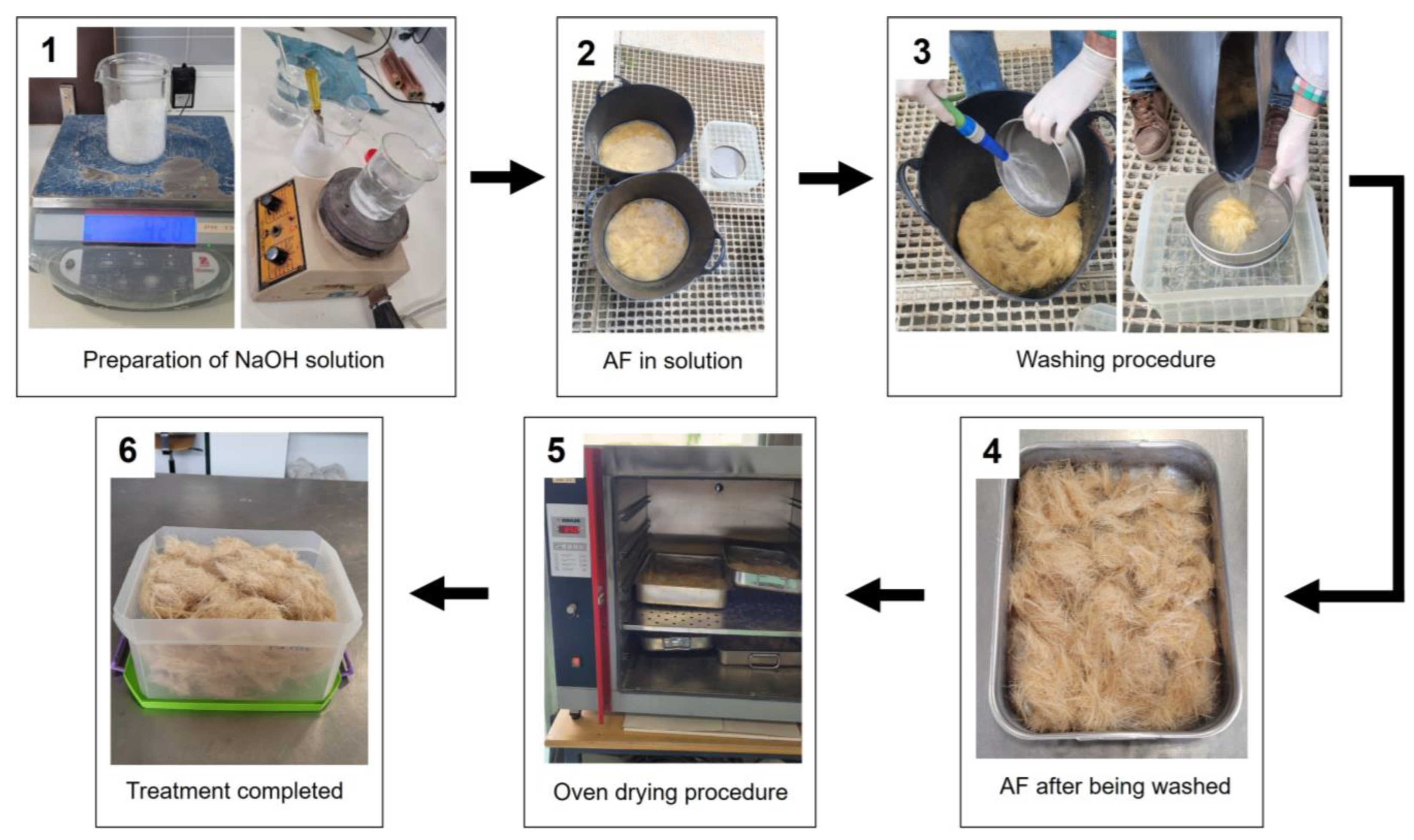

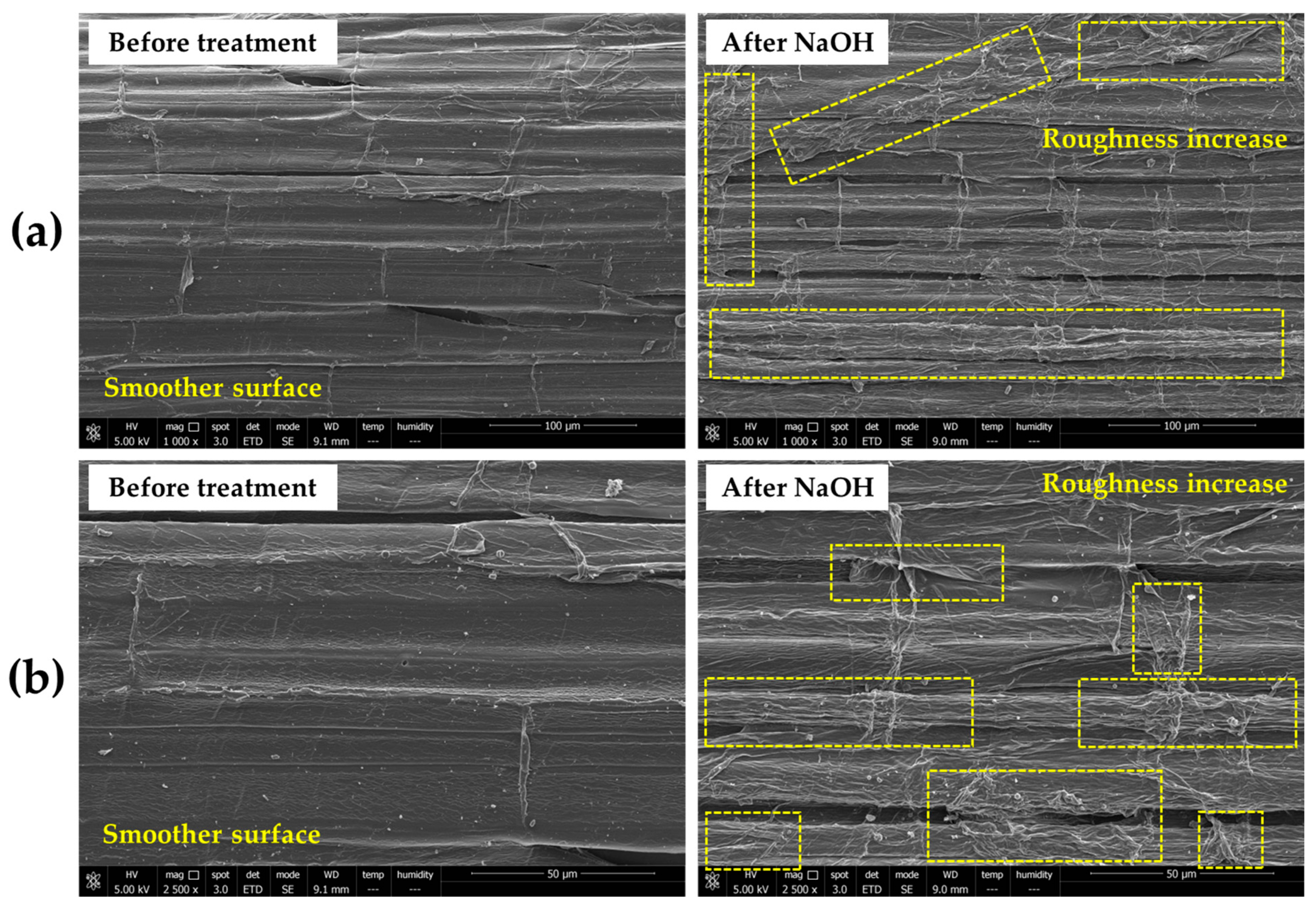

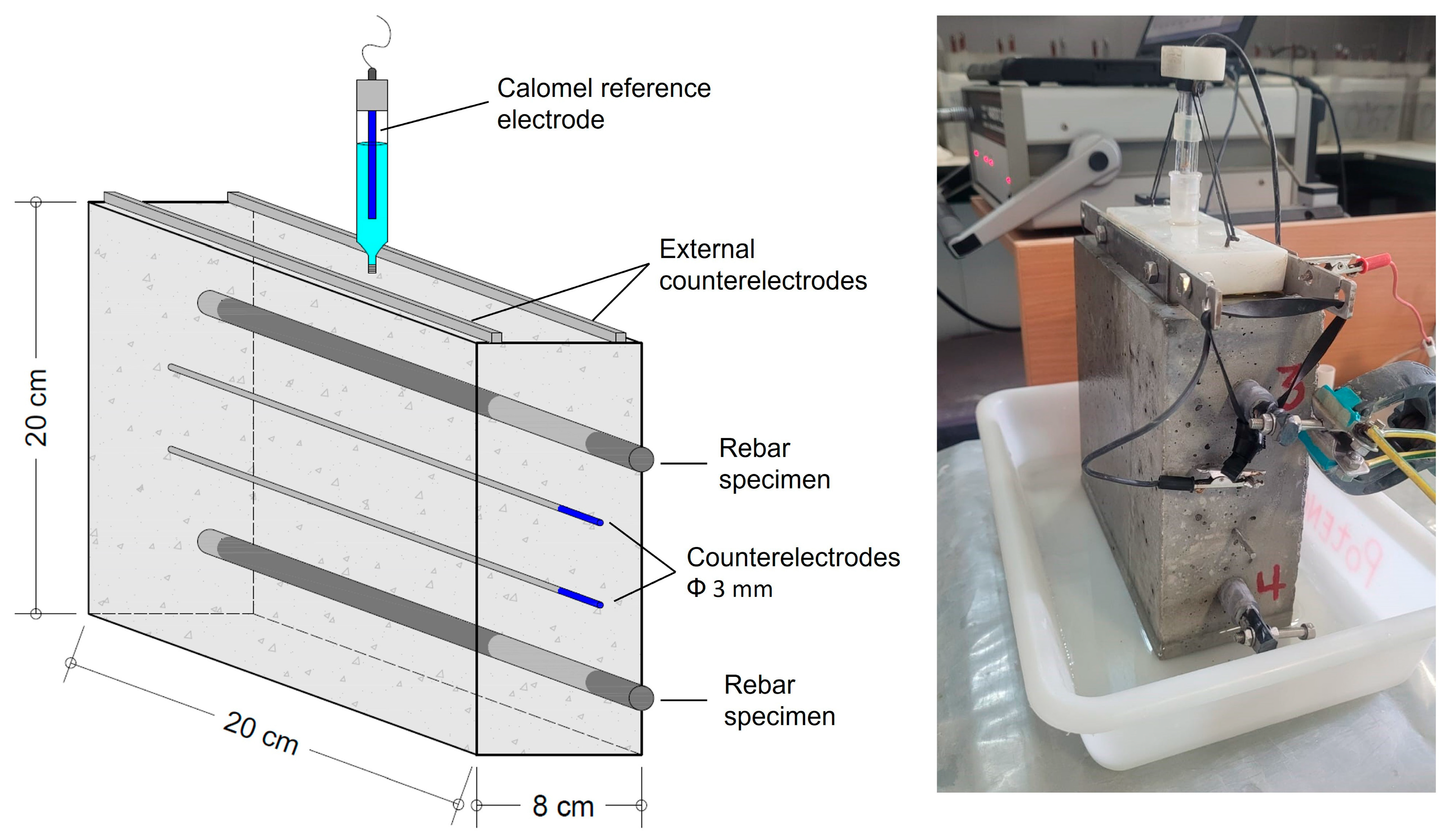
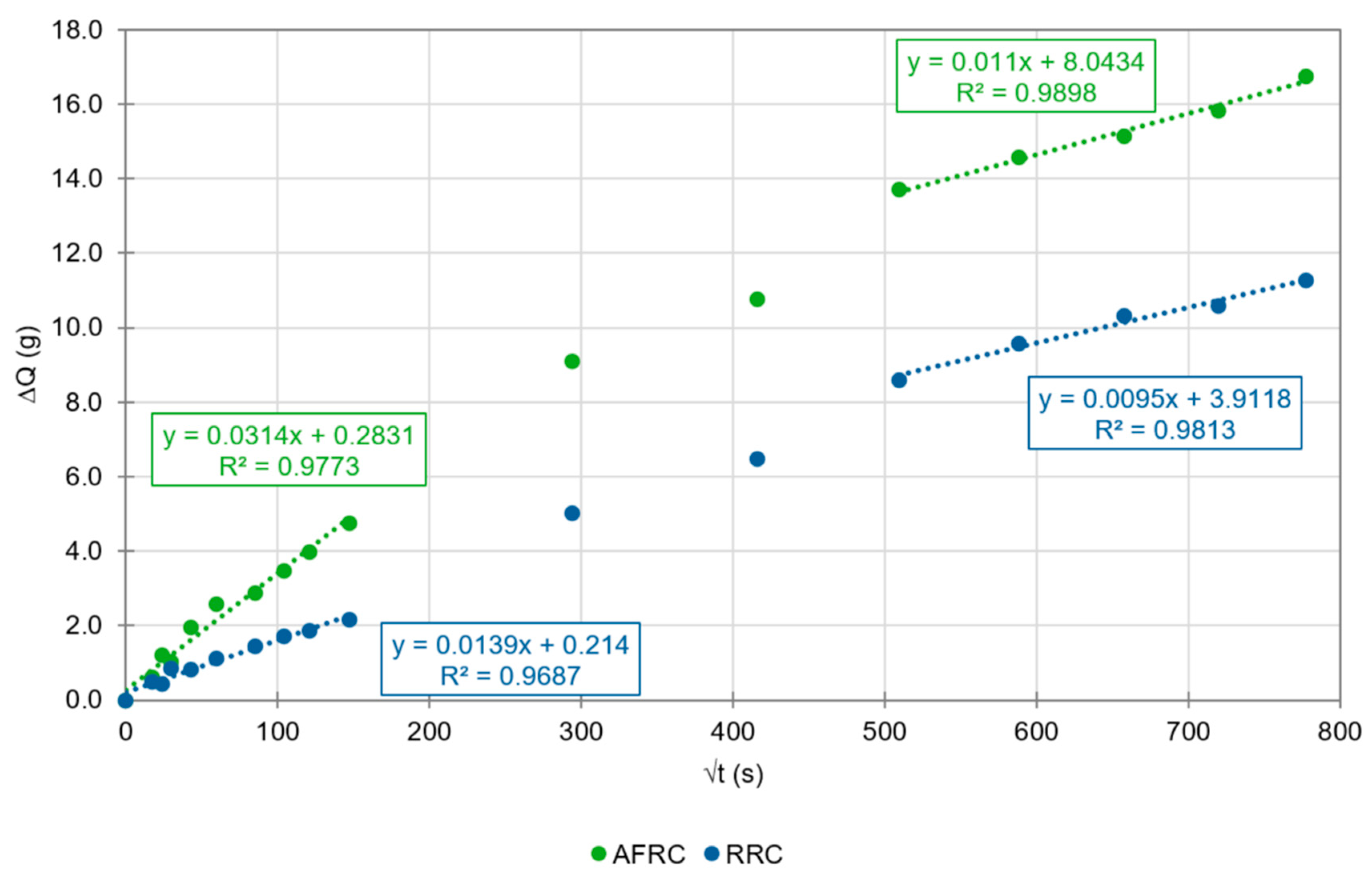
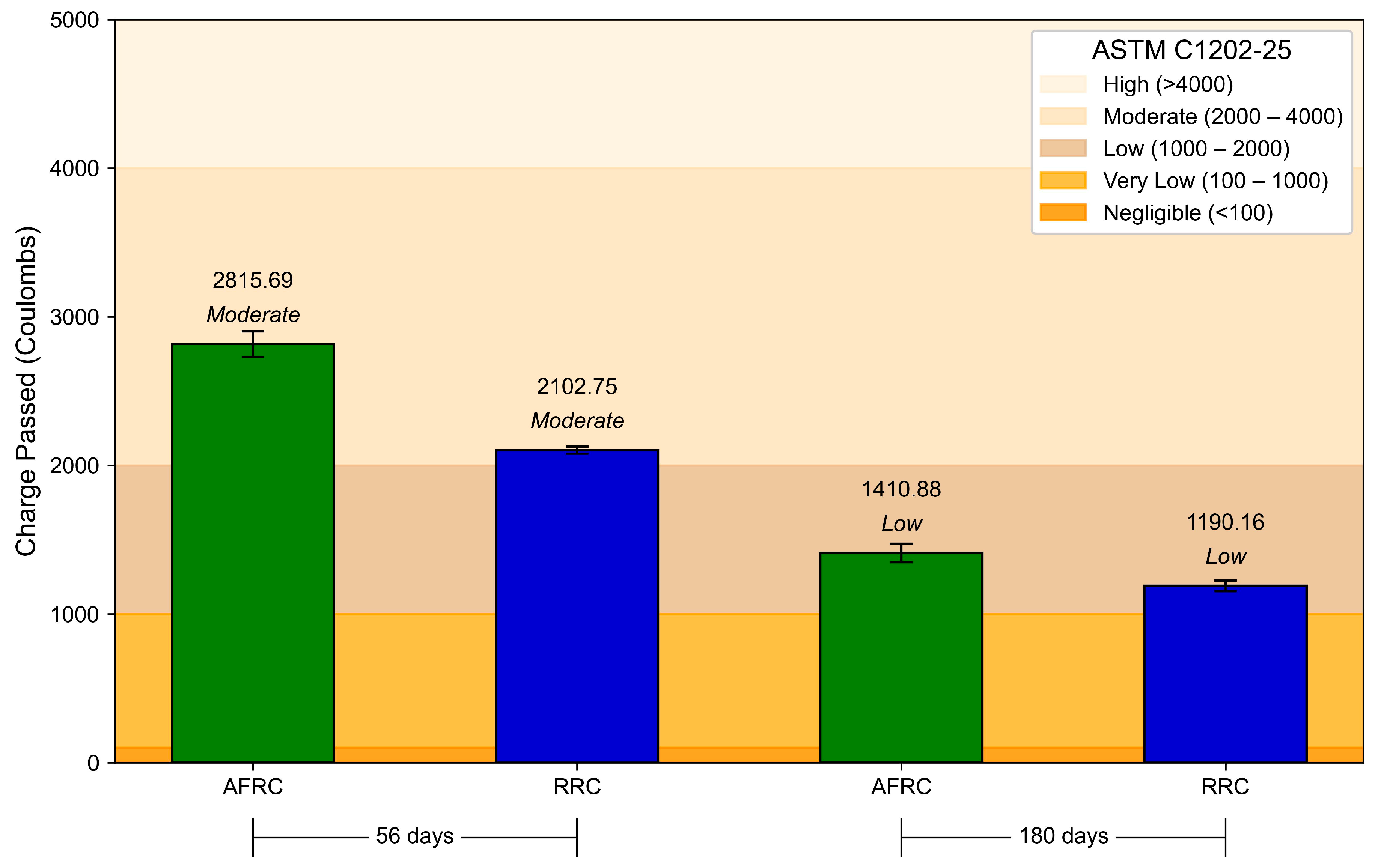


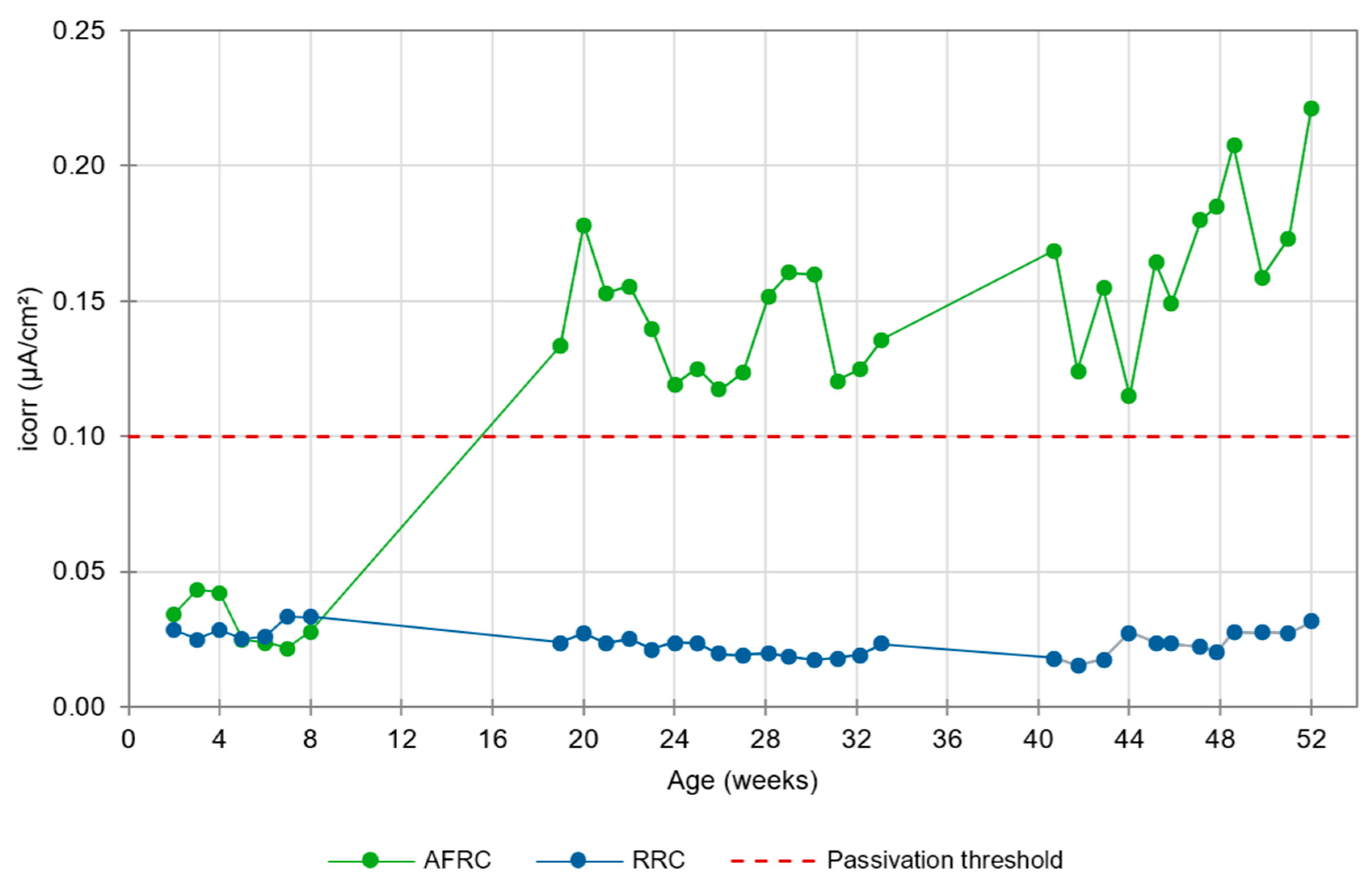
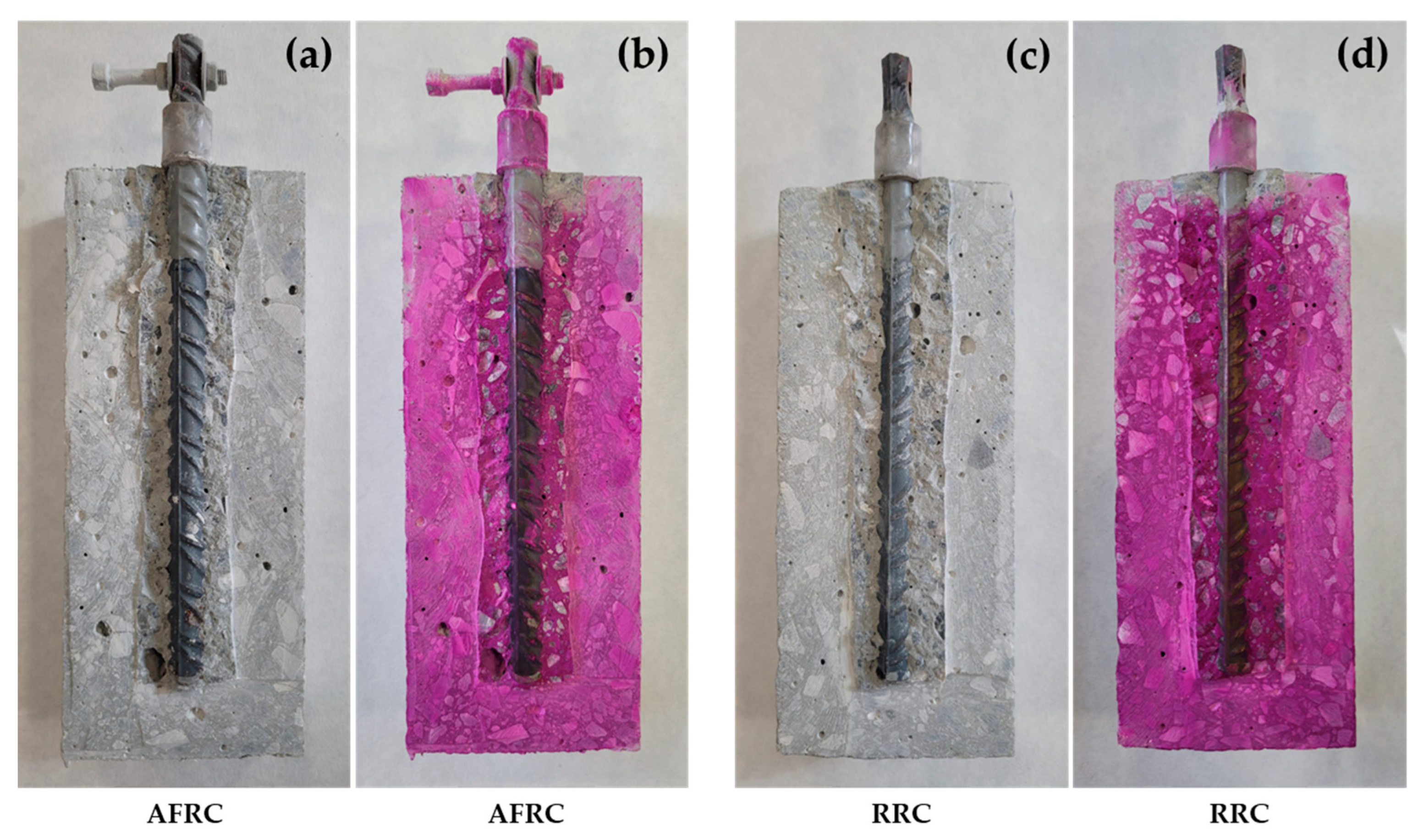
| Peak (cm−1) | Functional Group | Possible Assignment |
|---|---|---|
| 3300 | -OH | Cellulose, hemicellulose, and lignin |
| 2875 | C-H | Cellulose and hemicellulose |
| 1710 | C=O | Hemicellulose and pectin |
| 1590 | C=C | Lignin components |
| 1520 | C-H | Hemicellulose and pectin |
| 1240 | C-O | Lignin |
| 1100 | C-O-C | Cellulose |
| 1040 | C-O | Hemicellulose and lignin |
| 980 | Glycosidic links | Polysaccharide |
| 840 | C-OH | β-glycosidic linkages |
| Length (mm) | Water Absorption (%) | Cross Section (mm2) | Tensile Resistance (MPa) |
|---|---|---|---|
| 30 ± 2 | 70.7 ± 5.3 | 0.04 ± 0.01 | 465.2 ± 31.4 |
| Water | Cement | Filler | NS | NCG | NMG | SP | AF | |
|---|---|---|---|---|---|---|---|---|
| AFRC | 165 | 300 | 173.5 | 680 | 536 | 536 | 6.6 | 2.5 |
| RRC | 165 | 300 | 173.5 | 680 | 536 | 536 | 6.6 | - |
| Slump Flow | V-Funnel | J-Ring | L-Box | |
|---|---|---|---|---|
| PJ (mm) | tv (s) | PJ (mm) | PL | |
| AFRC | 770 | 18.2 | 9.5 | 0.8 |
| RRC | 760 | 17.1 | 9.0 | 1.0 |
| Permissible range | 550–850 | ≤25 | ≤10 | ≥0.80 |
| Compressive Strength | Flexural Strength | |||||
|---|---|---|---|---|---|---|
| MPa | SD | CV (%) | MPa | SD | CV (%) | |
| AFRC | 54.06 | 0.88 | 1.63 | 8.33 | 0.36 | 4.33 |
| RRC | 55.07 | 0.84 | 1.52 | 7.76 | 0.26 | 3.29 |
| Porosity | Water Absorption | |||
|---|---|---|---|---|
| (%) | SD | (%) | SD | |
| AFRC | 10.96 | 0.21 | 5.3 | 0.11 |
| RRC | 10.53 | 0.15 | 4.9 | 0.09 |
| Initial Absorption | Secondary Absorption | |
|---|---|---|
| AFRC | 3.14 | 1.10 |
| RRC | 1.39 | 0.95 |
Disclaimer/Publisher’s Note: The statements, opinions and data contained in all publications are solely those of the individual author(s) and contributor(s) and not of MDPI and/or the editor(s). MDPI and/or the editor(s) disclaim responsibility for any injury to people or property resulting from any ideas, methods, instructions or products referred to in the content. |
© 2025 by the authors. Licensee MDPI, Basel, Switzerland. This article is an open access article distributed under the terms and conditions of the Creative Commons Attribution (CC BY) license (https://creativecommons.org/licenses/by/4.0/).
Share and Cite
Arvizu-Montes, A.; Alcivar-Bastidas, S.; Martínez-Echevarría, M.J. Experimental Study on the Effect of Abaca Fibers on Reinforced Concrete: Evaluation of Workability, Mechanical, and Durability-Related Properties. Fibers 2025, 13, 75. https://doi.org/10.3390/fib13060075
Arvizu-Montes A, Alcivar-Bastidas S, Martínez-Echevarría MJ. Experimental Study on the Effect of Abaca Fibers on Reinforced Concrete: Evaluation of Workability, Mechanical, and Durability-Related Properties. Fibers. 2025; 13(6):75. https://doi.org/10.3390/fib13060075
Chicago/Turabian StyleArvizu-Montes, Armando, Stefany Alcivar-Bastidas, and María José Martínez-Echevarría. 2025. "Experimental Study on the Effect of Abaca Fibers on Reinforced Concrete: Evaluation of Workability, Mechanical, and Durability-Related Properties" Fibers 13, no. 6: 75. https://doi.org/10.3390/fib13060075
APA StyleArvizu-Montes, A., Alcivar-Bastidas, S., & Martínez-Echevarría, M. J. (2025). Experimental Study on the Effect of Abaca Fibers on Reinforced Concrete: Evaluation of Workability, Mechanical, and Durability-Related Properties. Fibers, 13(6), 75. https://doi.org/10.3390/fib13060075








